Perles du Nord |
||||||||||||||||||||||
 |
 |
|||||||||||||||||||||
The set consists of: Knitted jumper with round yoke, multi-coloured Norwegian pattern and A-shape, worked top down. Sizes S - XXXL. Hat with multi-coloured Norwegian pattern. The set is worked in DROPS Flora.
DROPS 180-2 |
||||||||||||||||||||||
|
INFORMATION FOR THE PATTERN: DECREASE/INCREASE TIP: To work out how to decrease/increase evenly, count the total number of stitches on the needle (e.g. 120 stitches) and divide by the number of decreases/increases to be made (e.g. 18) = 6.6. In this example, decrease by knitting alternately every 5th and 6th stitch and every 6th and 7th stitch together. If you are increasing, do this after alternately every 6th and 7th stitch (increase 1 stitch by making 1 yarn over, on the next round, knit the yarn overs twisted and into the pattern so that there are no holes). ELEVATION: Insert 1 marker at the beginning of the round = mid back. Start from the right side with off white and knit until you have worked 8-8-9-10-10-11 stitches past the marker, turn, tighten the strand and purl 16-16-18-20-20-22 stitches. Turn, tighten the strand and knit 24-24-27-30-30-33 stitches, turn, tighten the strand and purl 32-32-36-40-40-44 stitches. Turn, tighten the strand and knit 40-40-45-50-50-55 stitches, turn, tighten the strand and purl 48-48-54-60-60-66 stitches. Turn, tighten the strand and knit 56-56-63-70-70-77 stitches, turn, tighten the strand and purl 64-64-72-80-80-88 stitches. Turn, tighten the strand and knit to mid back. PATTERN: Jumper: See diagrams A.1 to A.3. Choose diagram for your size. Hat: See diagrams A.4 and A.5. The diagrams show all the rows in the pattern seen from the right side. The whole of the pattern is worked in stocking stitch. KNITTING TIP (for the multi-coloured pattern): To prevent the knitting tension from becoming tighter when working pattern, it is important that the strands do not tighten at the back of the piece. You can increase the size of your needle when working pattern if you find you are working too tightly. INCREASE TIP (for the sides of the body): Start 2 stitches before the marker thread, make 1 yarn over, knit 4 (the marker thread sits in the middle of these 4 stitches), make 1 yarn over (= 2 stitches increased). On the next round knit the yarn overs twisted so that there are no holes. DECREASE TIP-1 (for mid under the sleeve): Work until there are 4 stitches left before the marker thread, knit 2 together, knit 4 (the marker thread sits in the middle of these 4 stitches), slip 1 stitch as if to knit, knit 1, pass the slipped stitch over the knitted stitch (= 2 stitches decreased). DECREASE TIP-2 (for the hat): Decrease after each marker thread as follows: Slip 1 stitch as if to knit, knit 1, pass the slipped stitch over the knitted stitch (= 1 stitch decreased). ---------------------------------------------------------- JUMPER: The piece is worked in the round with circular needle, top down. The sleeve is worked in the round with short circular needle, top down. Change to double pointed needles when you have decreased enough stitches. NECKLINE: Cast on 120-124-128-132-140-148 stitches with circular needle size 2.5 mm and off white. Knit 1 round. Then work rib (= knit 2 / purl 2). When the rib measures 3 cm, knit 1 round where you decrease 18-16-14-12-14-16 stitches evenly on round – read DECREASE/INCREASE TIP = 102-108-114-120-126-132 stitches. Continue to work the yoke as described below. YOKE: Change to circular needle size 3 mm. Knit 1 round. For a better fit you can now work a small ELEVATION in the back of the neck – see description above. When the elevation is complete, work A.1 in the round (= 17-18-19-20-21-22 repeats of 6 stitches). Continue the pattern in this way and increase as shown in the diagram. Read KNITTING TIP and REMEMBER THE KNITTING TENSION! On the round marked with a star in A.1 (i.e. the next to last round in A.1) there are 221-234-247-260-315-330 stitches on the needle, increase at the same time 11-22-33-36-21-22 stitches evenly on this round – read DECREASE/INCREASE TIP = 232-256-280-296-336-352 stitches. When A.1 is complete, work A.2 in the round (= 29-32-35-37-42-44 repeats of 8 stitches). Continue the pattern in this way, but on the round marked with a star in A.2 (i.e. the next to last round in A.2) increase 8-16-24-24-16-16 stitches evenly on round = 240-272-304-320-352-368 stitches. When A.2 is complete, work A.3 in the round (= 15-17-19-20-22-23 repeats of 16 stitches). Continue the pattern in this way and increase as shown in the diagram. When the last round in A.3 remains (marked with an arrow in each size) there are 315-357-399-420-462-483 stitches on the needle, increase at the same time 11-11-1-12-0-5 stitches evenly on the round = 326-368-400-432-462-488 stitches. The piece now measures approx. 24-26-28-30-32-34 cm from the cast-on edge, measured mid front. NOTE: If the piece measures less than this, continue working stocking stitch with green to the required length. The next round is worked as follows: Knit 50-55-59-65-71-76 stitches (= ½ back piece), place the next 64-75-83-86-90-93 stitches on a thread for sleeve, cast on 10-10-12-12-14-16 new stitches on the needle (= in the side under the sleeve), knit 99-109-117-130-141-151 stitches (= front piece), place the next 64-75-83-86-90-93 stitches on a thread for sleeve, cast on 10-10-12-12-14-16 new stitches on the needle (= in the side under the sleeve) and knit the remaining 49-54-58-65-70-75 stitches (= ½ back piece). Cut the strand. Body and sleeves are finished separately. THE PIECE IS NOW MEASURED FROM HERE! BODY: = 218-238-258-284-310-334 stitches. Insert 1 marker thread in the middle of the 10-10-12-12-14-16 stitches cast on under the sleeve in each side. Start the round by one of the marker threads and work stocking stitch in the round with green. When the piece measures 2 cm from the division, increase 1 stitch on each side of both marker threads – read INCREASE TIP (= 4 stitches increased). Increase in this way every 10th round (approx. every 3 cm) until required length (if the knitting tension is correct in height, there should be approx. 9 increase rows in each side). When the piece measures 30 cm from the division in all sizes, there are approx 254-274-294-320-346-370 stitches on the needle. Knit 1 round where you increase 82-90-98-104-114-122 stitches evenly on round – read DECREASE/INCREASE TIP = 336-364-392-424-460-492 stitches. Change to circular needle size 2.5 mm and work rib in the round (= knit 2 / purl 2) for 4 cm. Then cast off with knit over knit and purl over purl, but to prevent the cast-off edge being tight, you can make 1 yarn over on the needle after every 4th stitch AT THE SAME TIME as you cast off (the yarn overs are cast off as normal stitches). The jumper measures approx. 58-60-62-64-66-68 cm from the shoulder down. SLEEVE: Place the 64-75-83-86-90-93 stitches from the thread on one side of the piece on a short circular needle size 3 mm and in addition, knit up 1 stitch in each of the 10-10-12-12-14-16 stitches cast on under the sleeve = 74-85-95-98-104-109 stitches on the needle. Insert 1 marker thread in the middle of the 10-10-12-12-14-16 stitches under the sleeve. Start the round here and work stocking stitch in the round with green. When the sleeve measures 2 cm from the division, decrease 2 stitches mid under the sleeve – read DECREASE TIP. Decrease a total of 11-15-19-19-21-22 times in S: Every 9th round, in M: Every 6th round, in L and XL: Every 4th round, in XXL: Alternately every 3rd and 4th round and in XXXL: Every 3rd round = 52-55-57-60-62-65 stitches. When the sleeve measures 31-29-28-26-25-23 cm from the division (shorter measurements in the larger sizes due to longer yoke), knit 1 round where you increase 16-17-19-20-18-19 stitches evenly on round = 68-72-76-80-80-84 stitches. Change to double pointed needles size 2.5 mm and work rib in the round (= knit 2 / purl 2). When the rib measures 10 cm (or desired length) cast off with knit over knit and purl over purl, but to prevent the cast-off edge being tight, you can make 1 yarn over after every 4th stitch AT THE SAME TIME as you cast off (the yarn overs are cast off as normal stitches). The sleeve measures approx. 41-39-38-36-35-33 cm from the division. Work the second sleeve in the same way. ---------------------------------------------------------- HAT: The piece is worked in the round with short circular needle, bottom up. Change to double pointed needles as the number of stitches decreases. Cast on 128-136 stitches with circular needle size 2.5 mm and off white. Knit 1 round. Then work rib (= knit 2 / purl 2) for 4 cm. Change to short circular needle size 3 mm and knit 2 rounds – AT THE SAME TIME on the first round, increase 4-8 stitches evenly on round – read DECREASE/INCREASE TIP = 132-144 stitches. Work A.4 in the round (= 11-12 repeats of 12 stitches). On the last round in A.4 (marked with a star in the diagram), decrease 4-8 stitches evenly on round = 128-136 stitches. REMEMBER THE KNITTING TENSION! Now work A.5 in the round (= 16-17 repeats of 8 stitches). On the next to last round in A.5 (marked with a star in the diagram), decrease 8-4 stitches evenly on round = 120-132 stitches. The piece now measures approx. 16 cm in height. Continue working stocking stitch with green until the piece measures 20-23 cm. Insert 10-11 marker threads in the piece with 12 stitches between each marker thread. On the next round, decrease 1 stitch after each marker thread – read DECREASE TIP (= 10-11 stitches decreased). Decrease in this way every 2nd round a total of 8 times and then every round a total of 2 times = 20-22 stitches. On the next round knit all stitches together, 2 and 2 = 10-11 stitches. Cut the strand, pull it through the remaining stitches, tighten the strand and fasten well. The hat measures approx. 25-28 cm top down. |
||||||||||||||||||||||
Diagram explanations |
||||||||||||||||||||||
|
||||||||||||||||||||||

|
||||||||||||||||||||||
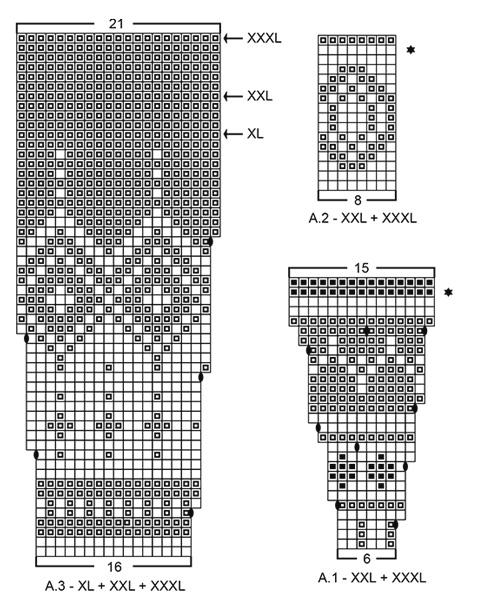
|
||||||||||||||||||||||

|
||||||||||||||||||||||
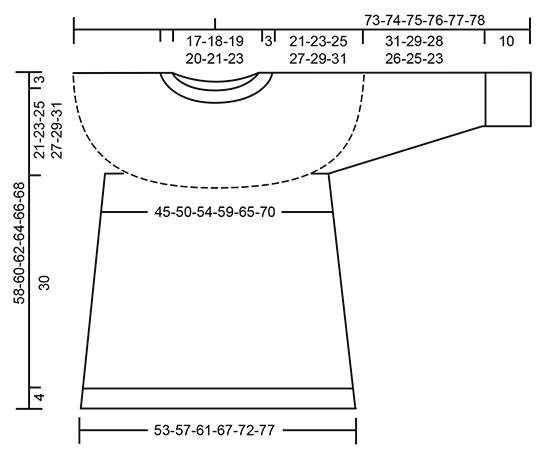
|
||||||||||||||||||||||
|
Have you made this or any other of our designs? Tag your pictures in social media with #dropsdesign so we can see them! Do you need help with this pattern?You'll find tutorial videos, a Comments/Questions area and more by visiting the pattern on garnstudio.com. © 1982-2024 DROPS Design A/S. We reserve all rights. This document, including all its sub-sections, has copyrights. Read more about what you can do with our patterns at the bottom of each pattern on our site. |
||||||||||||||||||||||








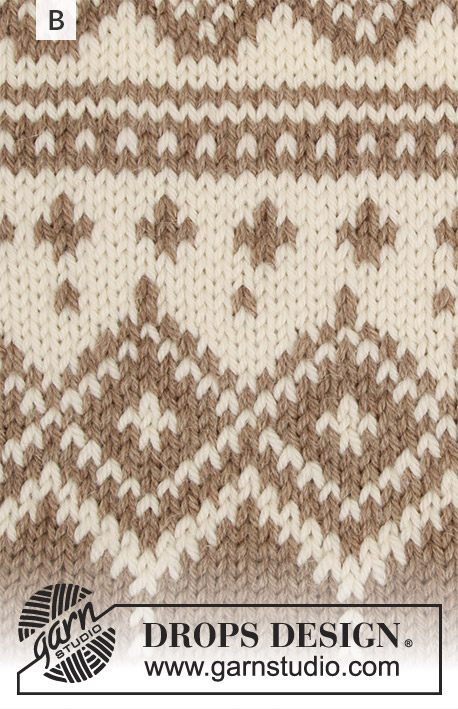




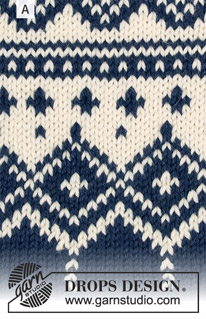
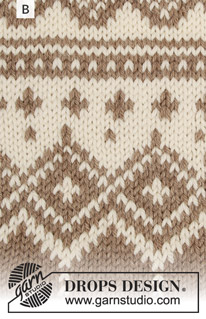



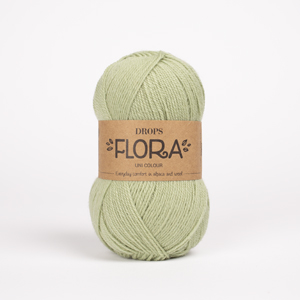
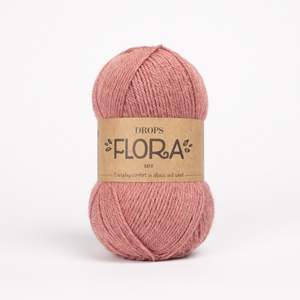


























































Comments / Questions (106)
W trzecim schemacie chyba jest bład, bo wzór nie wychodzi tak jak powinien, po schemacie pierwszych krzyzykow inna włoczką , co 18 ocxek dodane jest jedno, wiec nastepny schemat nie miesci sie regularnie jak na obrazku.
18.02.2020 - 11:03Finner ikke målene på denne genseren. Har bladd gjennom flere ganger. 😊
17.01.2020 - 12:46DROPS Design answered:
Hei Bergliot. Målene til genseren finner du på målskissen helt nederst på oppskriften. God Fornøyelse!
27.01.2020 - 13:03Når jeg vil printe Drops 180-2 ud får jeg kun hver anden side. Når jeg bestiller et KIT-180-2 hos RITO garn er der ingen opskrift med. Kan det være rigtigt. Jeg mener et KIT inde holder både garn og opskrift.
12.01.2020 - 15:44DROPS Design answered:
Hej Anita, hvis du bruger "skriv ud" knappen her på selve opskriften, så får du alle sider med. Når du klikker på print, kan du selv vælge hvilke sider du vil have med. Hvis du ikke har mulighed for at skrive ud, så sig det til Rito, så sender de en opskrift med. God fornøjelse!
15.01.2020 - 15:33Som så mange andre kommentarer forstår jeg ikke A3 For mig går det galt allerede i række 7 skla jeg srikke 4 natur 1 grøn 4 natur 1 grøn 4 natur 1 grøn 3 natur så der bliver 7 natur lige efter hinanden?? eller skal jeg slutte pinden af med 3 natur så det ender med 7 natur midtbagf?? Problemet er det samme i række 9 tænker hvis jeg får styr på de rækker kommer løsningen for mig også i række 12 som jeg heller ikke forstår
13.12.2019 - 22:42DROPS Design answered:
Hej Lene, jo det stemmer, som du også kan se på billedet så er der kun en prik efter hver tredje "stjerne" i bærestykket. God fornøjelse!
17.12.2019 - 12:12Stickar mönstret, men undrar överA3 och rad7 hur får jag mönstret att stämma slutar ju med 3batur Och börjar om med 4natur får ju då 7Natur i rad? Stickar stl. S
10.11.2019 - 19:08DROPS Design answered:
Hej. Det är så mönstret ska vara, om du ser på bilden så ser du att det stämmer att det ska vara 7 natur i rad där. Lycka till!
12.11.2019 - 08:44Hei, har så lyst til å strikke denne, men kan en ikke snu oppskrifta og strikke fra bånn ? Har aldri strikket fra toppen og ned. Har strikket i over 60 år. Mvh Betty
04.11.2019 - 15:31DROPS Design answered:
Hej Betty, det er meget enkelt at strikke ovenfra og ned og der er flere fordele. Se her:
How to knit a jumper top down from Garnstudio Drops design on Vimeo.
Vil du absolut ikke, så er det bare at starte nederste i opskriften ;) 05.11.2019 - 09:51Sono ferma all'ottavo ferro del diagramma n. 3 e mi risulta una crocina in più di quante dovrebbero essere. Non capisco dove ho sbagliato. Come posso fare? Grazie mille!
21.07.2019 - 12:47DROPS Design answered:
Buongiorno Letizia. Verifichi di avere il numero corretto di maglie. Se fino all’inizio del diagramma A3 le maglie sono corrette, potrebbe aver aumentato qualche maglia di troppo sulle righe del diagramma in cui sono previsti dei gettati. In quel caso è sufficiente disfare solo qualche riga. Buon lavoro!
21.07.2019 - 14:20Grazie per l'indicazione. Una cosa, potete chiarirmi questa frase "Inserire 1 segnapunti al centro delle 10-10-12-12-14-16 maglie sotto la manica. Iniziare qui il giro e lavorare a maglia rasata in tondo con verde. " ...il giro dove inizia? Sotto la manica dove c'è il segnapunti o dove inizio a riprendere la prima delle le 10 maglie? Grazie
11.04.2019 - 14:30DROPS Design answered:
Buongiorno Dea. Inserisce il segnapunti al centro delle maglie avviate. Il giro inizio dalla maglia dopo il segnapunti. Il segnapunti servirà anche da riferimento per gli aumenti ai lati del davanti/dietro. Buon lavoro!
11.04.2019 - 14:42Buongiorno, sarebbe utile un video che mostri come fare la manica in questi tipi di maglioni. Grazie.
11.04.2019 - 11:28DROPS Design answered:
Buongiorno Dea. Al momento un video non è disponibile. Può trovare un aiuto nella seguente lezione, oppure se ci spiega meglio la sua difficoltà possiamo provare ad aiutarla. Buon lavoro!
11.04.2019 - 11:59Hei Jeg sliter med å få mønsteret til å stemme i diagram A3, etter omgang 11, der det blir økt etter 18 masker hele omgangen. Da stemmer ikke omgang 13, med mønsteret i omgang 9...??
04.03.2019 - 14:02DROPS Design answered:
Hei Hanne. Nå vet ikke jeg hvilket av A.3 diagrammene du strikker, men jeg antar det er XL-XXXL siden du nevner mønster på omgang 13. Du på slutten av hver rapport på 11 omgang. 13 omgang strikkes slik: 4 masker natur, 1 maske grønn, 4 natur, 1 grønn, 4 natur 1 grønn. Videre strikkes 7 natur (3 fra slutten av første rapport og 4 fra begynnelsen av 2 rapport) osv. 14 omgang: 1 grønn, 2 natur, 3 grønn 2 natur osv. God fornøyelse
04.03.2019 - 15:22